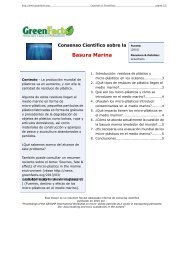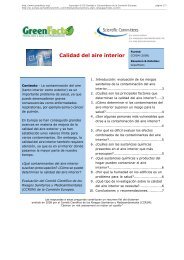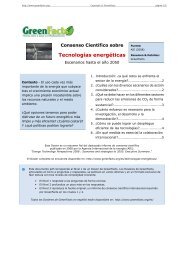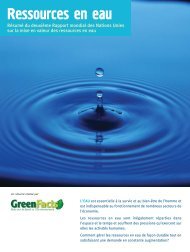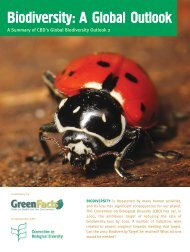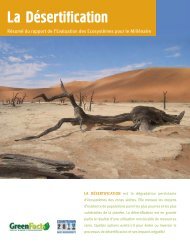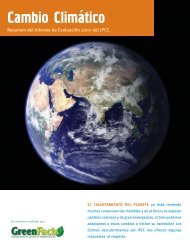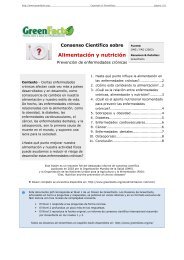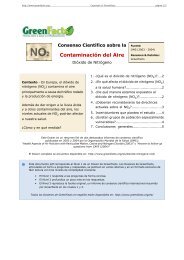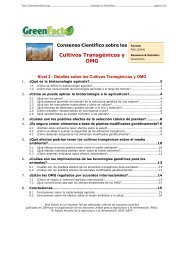Facts on Water Resources - GreenFacts
Facts on Water Resources - GreenFacts
Facts on Water Resources - GreenFacts
Create successful ePaper yourself
Turn your PDF publications into a flip-book with our unique Google optimized e-Paper software.
<str<strong>on</strong>g>Facts</str<strong>on</strong>g> <strong>on</strong> <strong>Water</strong> <strong>Resources</strong>A summary of the United Nati<strong>on</strong>s World <strong>Water</strong> Development Report 2A summary by:WATER is essential for human survival and well-being andimportant to many sectors of the ec<strong>on</strong>omy. However,resources are irregularly distributed in space and time, andthey are under pressure due to human activity.How can water resources be managed sustainably whilemeeting an ever increasing demand?
How much freshwater is available in different countries?The quantity of freshwater that is available for use by a given country in a given year, withoutexceeding the rate at which it is renewed, can be estimated taking into account the amount ofprecipitati<strong>on</strong>, water flows entering and leaving the country, and water shared with other countries.© Daniele SangermaniThe average amount available per pers<strong>on</strong> varies from less than 50 m 3 per year in parts of the MiddleEast to over 100 000 m 3 per year in humid and sparsely populated areas.The United Nati<strong>on</strong>s has kept a country by country database of such estimates for several decades.This database can be c<strong>on</strong>sulted at: www.fao.org/nr/aquastat/.Though the database has become a comm<strong>on</strong> reference tool, it has some drawbacks. Figures <strong>on</strong>lyindicate the maximum theoretical amount available for a country and may be an overestimati<strong>on</strong>.Moreover, annual and nati<strong>on</strong>al averages tend to mask local and seas<strong>on</strong>al differences. ?In what ways can human acti<strong>on</strong>s affect water resources?© UNEP/GRID-Sioux Falls<strong>Water</strong> resources face a host of serious threats, all caused primarily byhuman activity. They include polluti<strong>on</strong>, climate change, urban growth,and landscape changes such as deforestati<strong>on</strong>. Each of them has its ownspecific impact, usually directly <strong>on</strong> ecosystems and in turn <strong>on</strong> waterresources.If inadequately managed, activities like farming, forest-clearing, roadbuilding,and mining can lead to too much soil and suspended particlesending up in rivers (sedimentati<strong>on</strong>). This damages aquatic ecosystems,impairs water quality and hinders inland shipping.Polluti<strong>on</strong> can harm water resources and aquatic ecosystems. Majorpollutants include for instance organic matter and disease causingorganisms from waste water discharges, fertilisers and pesticidesrunning off from agricultural lands, acid rain resulting from air polluti<strong>on</strong>,and heavy metals released by mining and industrial activities.The effects of extracting too much water, both from surface waters andgroundwater, have been dramatic. A striking example is the drasticreducti<strong>on</strong> in size of the Aral Sea and Lake Chad. Little is being d<strong>on</strong>e toaddress the causes, which include poor water management practices anddeforestati<strong>on</strong>. In recent decades, much morewater has been extracted from undergroundsources. The benefits of withdrawinggroundwater are often short-lived, while thenegative c<strong>on</strong>sequences – lower water levelsand depleted resources, for example – can lasta l<strong>on</strong>g time.Climate change appears to increase existingpressures, for example in areas alreadysuffering from water shortages. Land andmountain glaciers have been shrinking morerapidly in recent years. Extreme weatherevents stemming from global warming, such asstorms and floods, are likely to become morefrequent and severe. However, based <strong>on</strong>current knowledge, scientists can <strong>on</strong>ly makegeneral predicti<strong>on</strong>s about the impact ofclimate change <strong>on</strong> water resources.Aral Sea: Diversi<strong>on</strong> of rivers for irrigati<strong>on</strong> has reduced drastically its size.This text is a faithful summary, by Green<str<strong>on</strong>g>Facts</str<strong>on</strong>g>, of the United Nati<strong>on</strong> <strong>Water</strong> Development Report 2, more specifically of chapter 4: The State of theResource. A web versi<strong>on</strong> of this summary, al<strong>on</strong>g with a l<strong>on</strong>ger, more detailed <strong>on</strong>e, can be found <strong>on</strong> www.greenfacts.org/en/water-resources/.
How can the growing demand for water be met?Meeting a c<strong>on</strong>tinuous and ever increasing demandfor water requires efforts to compensate for naturalvariability, and to improve the quality and quantityavailable.Rainwater has been collected for thousands of yearsin many parts of the world. Today, this technique isused in Asia to replenish underground supplies. It isrelatively inexpensive and has the advantage ofallowing local communities to develop and maintainthe required structures themselves.© Daniele SangermaniDiverting surface water into the ground can helpreduce losses from evaporati<strong>on</strong>, compensate forvariati<strong>on</strong>s in flow, and improve quality. Middle Eastand Mediterranean regi<strong>on</strong>s are applying thisstrategy.Dams and reservoirs have been built to store waterfor irrigati<strong>on</strong> and drinking. Moreover dams canprovide power and help c<strong>on</strong>trol floods, but they canalso bring about undesirable social andenvir<strong>on</strong>mental impacts.Transferring water between river basins can also help alleviateshortages. China, for instance, already has major interbasin links, and isplanning more. The impact of these projects <strong>on</strong> people and theenvir<strong>on</strong>ment must be m<strong>on</strong>itored closely.Wastewater is now reused for different purposes in many countries,especially in the Middle East, and this practice is expected to grow.Worldwide, n<strong>on</strong>-potable water is used for irrigati<strong>on</strong> and industrialcooling. Cities are also turning to water re-use to supplement drinkingwater supplies, taking advantage of progress in water treatment.Desalinated water – seawater and other salty water that has beenturned into freshwater – is used by cities and by industries, especially inthe Middle East. The cost of this technique has dropped sharply, but itrelies heavily <strong>on</strong> energy from fossil fuels and raises waste managementand climate change issues.How could water resources be developed sustainably?Using water resources sustainably is challenging because of the manyfactors involved, including changes in climate, the natural variability ofthe resource, as well as pressures due to human activity.At present, most water policy is still driven by short-term ec<strong>on</strong>omic andpolitical c<strong>on</strong>cerns that do not take into account science and goodstewardship. State-of-the-art soluti<strong>on</strong>s and more funding, al<strong>on</strong>g withmore data <strong>on</strong> water resources, are needed especially in developingnati<strong>on</strong>s.To assess the state of our water resources, we must fully appreciate theroles of different parts of the water cycle – such as rain, meltwater fromglaciers, and so <strong>on</strong>. Otherwise, it remains difficult to develop adequateprotecti<strong>on</strong> and mitigati<strong>on</strong> strategies.Poor water quality and unsustainable use of water resources can limitthe ec<strong>on</strong>omic development of a country, harm health and affectlivelihoods. More sustainable practices are starting to be adopted.The traditi<strong>on</strong>al resp<strong>on</strong>se to rising demand for water was to store surfacewater in reservoirs, divert flow to dry regi<strong>on</strong>s and withdraw groundwater.Now these methods are increasingly supplemented by water reuse,desalinati<strong>on</strong> and rainfall harvesting. Certain regi<strong>on</strong>s are even going tothe extreme of exploiting n<strong>on</strong>-renewable groundwater resources.Some countries have programs to reduce demand and losses from urbanwater distributi<strong>on</strong> systems but more efforts are necessary. However, thiswill involve changes in behaviour requiring educati<strong>on</strong> and politicalcommitment. Such efforts to c<strong>on</strong>serve water and reduce demand are not<strong>on</strong>ly useful in regi<strong>on</strong>s where water is in short supply, they can also bringec<strong>on</strong>omic benefits in wetter regi<strong>on</strong>s.Decentralised approaches to water resource management that focus <strong>on</strong>river basins are increasingly pursued even across borders. Exchanginginformati<strong>on</strong> between countries that share river basins will yield bothec<strong>on</strong>omic and envir<strong>on</strong>mental benefits.When managing water resources, more attenti<strong>on</strong> should be paid toincreasing existing natural resources and reducing demand and losses.
C<strong>on</strong>clusi<strong>on</strong>s <strong>on</strong> water resourcesOur water resources are under pressure. More reliable informati<strong>on</strong> is still needed regarding the quality and quantityof available water, and how this availability varies in time and from place to place. Human activities affect the watercycle in many ways, which need to be understood and quantified to manage water resources resp<strong>on</strong>sibly andsustainably.It has become evident that:■ Changes in climate are affecting water availability.■ Polluti<strong>on</strong>, water diversi<strong>on</strong>s and uncertainties about the abundance of water are threatening ec<strong>on</strong>omicgrowth, envir<strong>on</strong>ment, and health.■ Underground water is often overexploited and polluted.■ To augment water supply, traditi<strong>on</strong>al techniques – such as rainwater collecti<strong>on</strong> – are now beingsupplemented by newer technologies like desalinati<strong>on</strong> and water reuse.■ Political support is needed to improve informati<strong>on</strong> collecti<strong>on</strong> that can in turn enable better decisi<strong>on</strong> makingabout the management and use of water.GLOSSARY GLOSSARY GLOSSARY GLOSSARY GLOSSARY GLOSSARY GLOSSARY GLOSSARYBiodiversity — A c<strong>on</strong>tracti<strong>on</strong> of biologicaldiversity. Biodiversity reflects the number,variety and variability of living organisms.It includes diversity within species(genetic diversity), between species(species diversity), and betweenecosystems (ecosystem diversity).Climate change — Defined by the UnitedNati<strong>on</strong>s C<strong>on</strong>venti<strong>on</strong> <strong>on</strong> Climate Change as“change of climate which is attributeddirectly or indirectly to human activity thatalters the compositi<strong>on</strong> of the globalatmosphere and which is in additi<strong>on</strong> t<strong>on</strong>atural climate variability observed overcomparable time periods”.Ecosystem — An ecological unit made up of acomplex system of interacti<strong>on</strong>s betweenliving communities (plants, animals, fungi,and microorganisms) and the envir<strong>on</strong>mentthey live in. Ecosystems have no fixedboundaries; a single lake, a watershed, oran entire regi<strong>on</strong> could be c<strong>on</strong>sidered anecosystem.Freshwater — <strong>Water</strong> that is not salty, forinstance water found in lakes, streams,and rivers, but not the ocean. Allfreshwater ultimately comes fromprecipitati<strong>on</strong> of atmospheric water vapor,reaching inland lakes, rivers, andgroundwater bodies directly, or aftermelting of snow or ice.Glacier — A moving body of ice that forms <strong>on</strong>land from the accumulati<strong>on</strong> andcompacti<strong>on</strong> of snow, and that flowsdownslope or outward due to gravity andthe pressure of its own weight.Groundwater — <strong>Water</strong> beneath the Earth'ssurface in the spaces between soilparticles and between rock surfaces.Sustainability — A characteristic or statewhereby the needs of the present andlocal populati<strong>on</strong> can be met withoutcompromising the ability of futuregenerati<strong>on</strong>s or populati<strong>on</strong>s in otherlocati<strong>on</strong>s to meet their needs andaspirati<strong>on</strong>s.<strong>Water</strong> cycle — The process by which watertravels in a sequence from the air(c<strong>on</strong>densati<strong>on</strong>) to the Earth (precipitati<strong>on</strong>)and returns to the atmosphere(evaporati<strong>on</strong>). It is also referred to as thehydrologic cycle. Human use of water cantransform the water cycle throughirrigati<strong>on</strong> or the c<strong>on</strong>structi<strong>on</strong> of dams, forexample.
<str<strong>on</strong>g>Facts</str<strong>on</strong>g> <strong>on</strong> this publicati<strong>on</strong>This leaflet presents a faithful summary by Green<str<strong>on</strong>g>Facts</str<strong>on</strong>g> of the sec<strong>on</strong>d United Nati<strong>on</strong>s World <strong>Water</strong> Development report “<strong>Water</strong>, a sharedresource” (2006). More specifically, it covers chapter 4 of the report which addresses “The State of the Resource”.The World <strong>Water</strong> Development Report (WWDR) is a comprehensive review carried out every three years, providing an authoritativepicture of the state of the world’s freshwater resources. It is a joint undertaking of 24 UN agencies in partnership with governments andother stakeholders, coordinated by the World <strong>Water</strong> Assessment Program of UN-<strong>Water</strong>.It presents a comprehensive picture of freshwater resources in all regi<strong>on</strong>s and most countries of the world and examines a range of keyissues including populati<strong>on</strong> growth and increasing urbanizati<strong>on</strong>, changing ecosystems, food producti<strong>on</strong>, health, industry and energy, aswell as risk management, valuing and paying for water and increasing knowledge and capacity.This publicati<strong>on</strong> was produced by:Published with the support of:Printed with the support of:Distributed with the support of:This summary, al<strong>on</strong>g with a more detailed <strong>on</strong>e, can be found <strong>on</strong>www.greenfacts.org/en/water-resources/Green<str<strong>on</strong>g>Facts</str<strong>on</strong>g> is an independent n<strong>on</strong>-profit organizati<strong>on</strong> that publishes faithful <strong>on</strong>line summaries of scientificc<strong>on</strong>sensus documents produced by internati<strong>on</strong>al bodies such as the Intergovernmental Panel <strong>on</strong> Climate Change,the Millennium Ecosystem Assessment or the World Health Organizati<strong>on</strong>. All Green<str<strong>on</strong>g>Facts</str<strong>on</strong>g> summaries are peerreviewed by independent experts.www.greenfacts.org | 2009@greenfacts.org | Tel: +32 (0)2 211 34 88Avec le soutien du Ministre de la Recherchescientifique de la Régi<strong>on</strong> de Bruxelles-CapitaleMet de steun van de Minister van Wetenschappelijk Onderzoekvan het Brussels Hoofdstedelijk GewestWith the support of the Minister of Scientific Research of theBrussels Capital Regi<strong>on</strong>Editeur resp<strong>on</strong>sable: Jacques Wirtgen, Green<str<strong>on</strong>g>Facts</str<strong>on</strong>g> asbl/vzw, Rue des Palais 44 Paleizenstraat, 1030 Brussels, Belgium ■ C<strong>on</strong>cept & layout: beëlzePub ■ Printed <strong>on</strong> 100% recycled paperBRUSSELS-EUCHAPTER COR-EUTexts © Green<str<strong>on</strong>g>Facts</str<strong>on</strong>g> asbl/vzw – reproducti<strong>on</strong> welcome; please c<strong>on</strong>tact Green<str<strong>on</strong>g>Facts</str<strong>on</strong>g> for c<strong>on</strong>diti<strong>on</strong>s.




